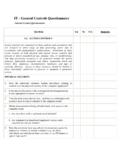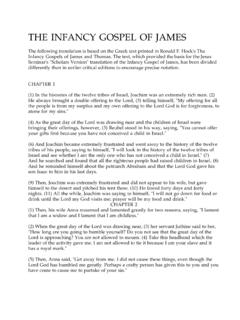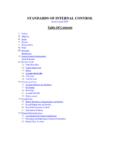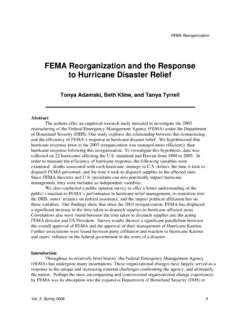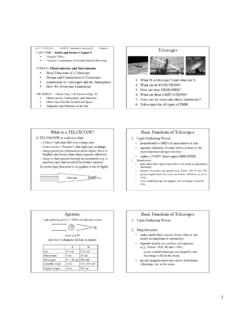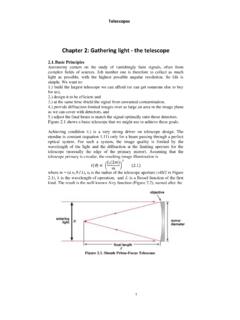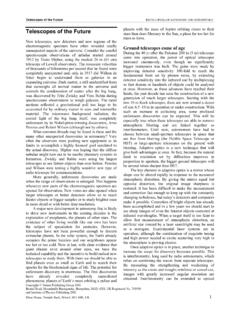Transcription of INTRODUCTION TO THE TELESCOPE - asu.edu
1 AST 113/114 Fall 2014 / Spring 2016 INTRODUCTION to the TELESCOPE 2016 Arizona State University Page 1 of 19 NAME: _____ INTRODUCTION TO THE TELESCOPE What will you learn in this Lab? For a few of the labs this semester, you will be using an 8-inch Celestron TELESCOPE to take observations. This lab will introduce you to the TELESCOPE itself and some properties of a TELESCOPE . Observations will be made to illustrate the different TELESCOPE properties. What do I need to bring to the Class with me to do this Lab? For this lab you will need: A copy of this lab script A pencil Your flashlight Your star wheel Your Audubon field guide Scientific calculator I. INTRODUCTION : In this lab exercise you will become familiar with the parts of a TELESCOPE and how to use one. You will also become familiar with some TELESCOPE properties and use observations to illustrate these properties.
2 These properties include: Remember, telescopes are precision instruments; be careful using them. Ask your instructor for help when you are in doubt about what to do. Lab Goals: Learn to set-up and operate the Celestron 8 TELESCOPE . Investigate how the focal length of the eyepiece affects the magnification and field of view of the TELESCOPE . Understand the terms (1) light gathering power, (2) resolving power, and (3) scale and know how they factor into the properties of a TELESCOPE . Make measurements with a TELESCOPE and understand how those measurements relate to the properties being explored. AST 113/114 Fall 2014 / Spring 2016 INTRODUCTION to the TELESCOPE 2016 Arizona State University Page 2 of 19 II. Parts of ASU s CPC Series TELESCOPE : Primary Mirror: This is the large mirror at the TELESCOPE 's lower end that 'collects' and focuses the light so that we can see fainter stars than with our 'naked' eyes.
3 ASU astronomy labs currently use 8-inch telescopes. This means the diameter of the primary mirror is 8 inches. These are called reflecting telescopes. Mounting: The mounting supports the TELESCOPE and allows it to be moved in two directions (or axes): one in the same sense as the Earth rotates (right ascension) and the other in a north/south direction (declination). Optical Tube: The optical tube holds the optical parts (eyepiece, primary, and secondary mirrors for reflecting telescopes) in the correct position. Clock Drive: The clock drive turns the TELESCOPE at the same rate as the Earth turns, but in the opposite direction so that the TELESCOPE stays pointed at one particular location in the sky ( , a star). Hand Control: The hand control is the primary method used to interface with the Celestron telescopes.
4 The four direction arrows allow you to slew the TELESCOPE in any desired direction or to better center an object in the eyepiece s field of view. Star Diagonal: The star diagonal diverts light at a right angle from the light path of the TELESCOPE . For astronomical observing, this allows you to observe in positions that are more comfortable than if you were to look along the axis of the optical tube. Finderscope: The finderscope is a smaller TELESCOPE with less magnification and a larger field of view. It is attached to the side of the main TELESCOPE and points in the same direction as the main TELESCOPE . The larger field of view makes it easy to initially locate a star in the finder TELESCOPE , hence the name finder. After a star is centered on the cross hairs in the finder, it will also be visible in the eyepiece of the main TELESCOPE .
5 DO NOT touch the finderscope for any reason. Do not use it as a handle to move the scope, or attempt to adjust it in any way. Eyepiece: This is the part you look through! Each eyepiece is identified by its focal length, which is stamped in white letters on the casing ( , 18 mm, 25 mm, etc.) Focus Adjustment: Once you have the star in the main eyepiece, focus on it sharply. It may help to remove your glasses. If you are observing faint objects, try using averted vision. That is, look at the object out of the corner of your eye. This works because the light detecting cells used by averted vision are more sensitive than those used by direct vision. It also will help to turn all the lights out and wait a few minutes for your eyes to become dark adapted. Tripod: Each TELESCOPE rests on a tripod that has been carefully leveled for its location on the observation deck.
6 A TELESCOPE s ability to accurately track a desired AST 113/114 Fall 2014 / Spring 2016 INTRODUCTION to the TELESCOPE 2016 Arizona State University Page 3 of 19 target is best maintained by keeping the TELESCOPE on a level base. DO NOT move or adjust the tripod in any way during the duration of the outdoor labs. Fork Arms: The Celestron telescopes are held in place by fork arms and are part of the slewing mechanism that allows proper tracking of celestial objects. NEVER grab the fork arms or body of the TELESCOPE to move/adjust the TELESCOPE . The different components of the Celestron 8-inch reflecting TELESCOPE is diagrammed in Fig. 1 on the next page. III. Properties of a TELESCOPE : Light Gathering Power: The primary function of an astronomical TELESCOPE is to collect light. The light gathering power of a TELESCOPE is measured by the area of the light collector (either a lens or a mirror), though a TELESCOPE 's size is always specified by the diameter of its primary mirror.
7 The area of a circular primary mirror is given by: A = (D/2)2, where A is the area of the mirror, and D is the diameter of the mirror. Thus, comparing the light gathering power of a 14-inch and 8-inch telescopes, we find the 14-inch has times greater light gathering power. Focal Length: For a simple mirror, the focal length is the distance between that mirror and the place where the image is formed. In a TELESCOPE with more than one optical element (or mirror), the effective focal length is often longer than the TELESCOPE tube itself. It is useful to know the focal length of the TELESCOPE or eyepiece that you are using. The focal lengths of the ASU telescopes are: focal length = 2000mm, for the 8-inch Celestron telescopes The focal lengths of the ASU eyepieces are stamped on the end of each eyepiece. Typical eyepiece focal lengths are 40mm (lowest power), 24mm, 18mm, etc.
8 Magnification of a TELESCOPE : The magnifying power of a TELESCOPE is determined by the focal length of both the TELESCOPE and the eyepiece used. An eyepiece with a shorter focal length gives a greater magnification. MAGNIFICATION OF TELESCOPE = TELESCOPE FOCAL LENGTHEYEPIECE FOCAL LENGTH Field of View of a TELESCOPE : The angular size of the piece of sky seen through a TELESCOPE is called its field of view ( , FoV) and depends both on the TELESCOPE and the eyepiece used. Since the FoV is an angle, it is measured in degrees ( ), arcminutes ( ), or arcseconds ( ). For a given TELESCOPE , the greater the focal length of the eyepiece, the greater the field of view. If you double the focal length of the eyepiece, you also double the 113/114 Fall 2014 / Spring 2015 INTRODUCTION to the TELESCOPE 2016 Arizona State University Page 4 of 18 AST 113/114 Fall 2014 / Spring 2015 INTRODUCTION to the TELESCOPE 2016 Arizona State University Page 5 of 18 Resolving Power: The resolving power (also called angular resolution) is the ability of a TELESCOPE to separate two close images or to see fine detail in an image.
9 Greater magnification WILL NOT resolve two images that are closer than the resolution of a TELESCOPE . The limit, called the Rayleigh criterion, depends on the diameter of the TELESCOPE 's primary mirror (D) and the color (or wavelength) of the light observed. For visible light, the minimum separation of two objects which can just be resolved is: = , where is the angular separation of two stars (in arcseconds), and D is the diameter of the TELESCOPE 's primary mirror (in inches). For example, the resolving power for the 8-inch telescopes is = . However, you may not actually be able to see two images this close together because of atmospheric conditions ("seeing"), relative brightness of the objects, etc. Scale of a TELESCOPE : The scale at the focus of any astronomical TELESCOPE is the ratio of the angular size of an object in the sky to its image size with that TELESCOPE ( , how large the object would look if you were to photograph it with that TELESCOPE ).
10 Scale= angular size of an object on the skysize of the final image using the TELESCOPE The scale is constant for a particular TELESCOPE and depends only on the focal length of the primary mirror. The scale is usually expressed in units of degrees per millimeter ( /mm) or arcseconds per millimeter ( /mm). Examples: 1. If the scale scale = 30 / mm ..an object which is 30 arcseconds in angular size in the sky will appear 1 mm in diameter when viewing that object through the TELESCOPE , an object 60 arcseconds in size will appear 2 mm in diameter when viewing through the TELESCOPE , etc. 2. If the scale scale = 2 /mm ..an object which is 2 degrees in angular size in the sky will appear 1 mm in diameter when viewing that object through the TELESCOPE , an object 4 degrees in size will appear 2 mm in diameter when viewing through the TELESCOPE , etc.

